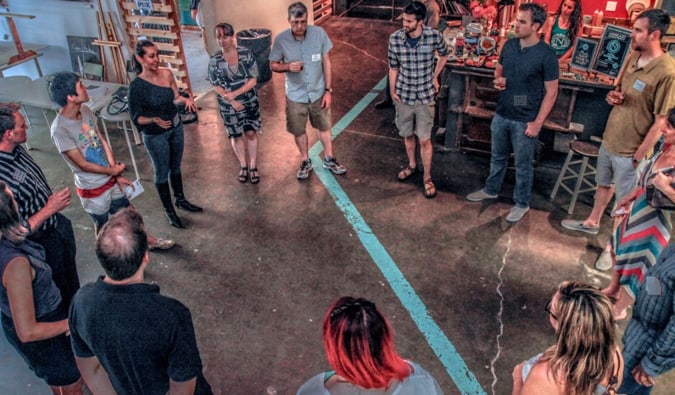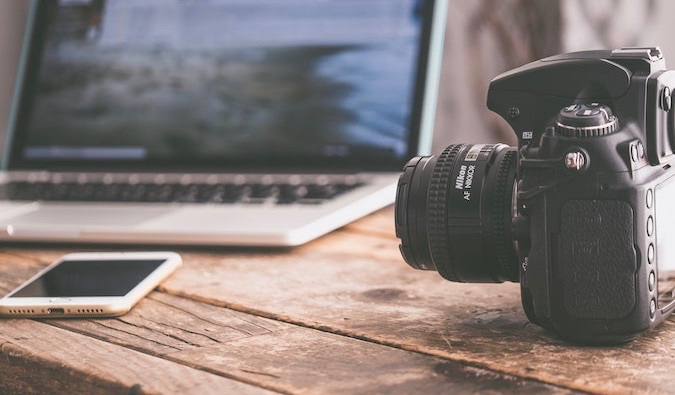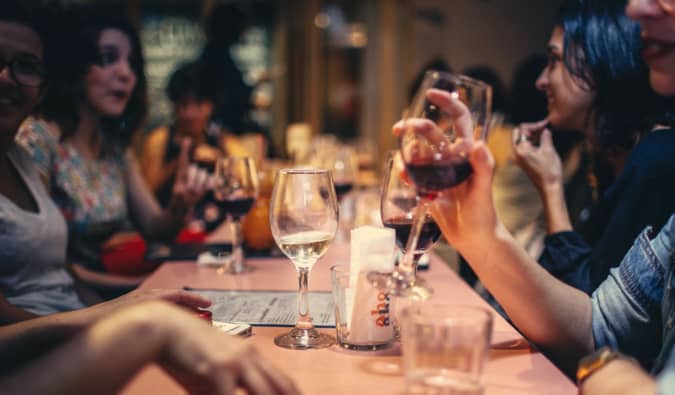
One of the most common questions I get asked by new travelers is, “Will it be hard to meet people when I’m traveling?” Not everyone is outgoing, extroverted, or comfortable in social situations. When it comes to traveling, introverts will need to work a little harder to interact and connect with their fellow travelers. In this guest post, Vanessa Van Edwards from ScienceofPeople.com shares her expert behavioral tips and tricks on how to be meet people and be more interesting when you travel (or just in general).
They say travel is an itch. For me, it was more like a full-body rash.
Was that metaphor awkward? Yeah, I’m not surprised. That’s me. My name is Vanessa, and I am a recovering awkward person.
Growing up, I was terrified of recess. I couldn’t make a friend for the life of me, and my crushes gave me hives. Literally, full-body hives from social anxiety.
When I got bit by the travel bug, I hoped and prayed I would be able to do it solo and that travel would obliterate the anxiety I had. I wanted to travel to be an escape from my past and a way to be someone new.
These days I research what makes people tick, what drives our actions, and how to hack human behavior for good at my website, The Science of People. As a recovering awkward person, I’m fascinated by what makes people tick and how we can overcome our social anxiety.
For most of us, it’s not easy to make friends or know what to say to strangers — especially ones from a different culture or background. While we all have this image of making beautiful connections when we travel, experience and research have shown me that it’s not as easy as we imagine.
But, experience and research have also shown me that it doesn’t have to be hard either.
Here are my favorite tricks and tips for building friendships, starting conversations, and being more interesting while traveling.
Use Identifiers

I never realized how many hundreds of opportunities there are to meet people while traveling — whether fellow travelers on buses, trains, and planes or locals at supermarkets, museums, and malls. It’s best, though, if you can find a way to give people a reason to talk to you. This is where identifiers can come in handy.
Identifiers are objects, clothing, or props that identify commonalities between people. It’s something that someone can use as a reason to talk to you. You often want to wear, carry, or showcase in your everyday appearance, such as:
- A T-shirt of your favorite band
- A hat with a funny saying
- A flag (or flags) on your backpack
- A unique or heritage piece of jewelry
- A sports jersey with a team’s logo on it
- A classic book visible in your back pocket or backpack
These items make it easier for others to talk to you, whether it’s a stranger approaching you on the street or a seatmate on a bus. Why? Because they can start a conversation. They give you and your new friends something to break the ice and talk about. And once you start talking, it becomes easy to just keep talking.
One of my favorite identifiers are my cowboy boots. I wear them when I travel, and people who also love country music and rodeos bring them up and we get to talking.
Be Approachable

If you want to meet people, you have to be approachable. I used to sit with my arms crossed, backpack on lap, head down in a book. Then I met Sarah at a hostel in New Zealand. I had been in Christchurch for about three days already when this nice Australian came over to my table in the common room.
“Hey! I saw your Hello Kitty wallet. Love it.” (Yes, I use Hello Kitty sometimes as an identifier to attract nice people with soft hearts.)
We carried on a friendly conversation and she finally said something I’ll never forget:
“You know, I saw you the first day at breakfast and the second day at lunch and then this morning. But you always looked like you didn’t want anyone to talk to you, so I never said hi. If you want people to talk to you, then you have to look like you want to be talked to!”
Boom! Her statement hit me like a ton of bricks. She was right. I did look closed off…because I felt closed off.
Body language sends so many signals about your intentions to people that it is often more important than what you say. Research shows that a minimum of 60% of our communication is nonverbal. We send signals with our body language, facial expressions, and tone of voice. So use approachable body language, whether that’s in the common room of your hostel, at a local pub, or waiting for your luggage at the airport. Make it easy for people to say hello. Here’s how:
- Keep your hands visible. Our brains need to see people’s hands to fully trust them since back in caveman times, humans relied on seeing hands to know they weren’t going to be attacked and to check for weapons. To this day, our hands serve as our trust indicators, so keep them out of your pockets and out of your luggage.
- Leave your limbs uncrossed. Standing or sitting with your legs straight and arms at your side makes you look relaxed and confident. Plus, research shows that people struggle to get along when one or both have crossed limbs. Think: closed body, closed mind.
- Make eye contact with strangers. When two people make eye contact, it triggers the release of oxytocin, a bonding hormone. If the other person is open to connection, this will prime them to want to talk to you.
To determine who you should approach, look for the above signs in other people, as they typically signal trustworthiness, friendliness, and openness.
A fun example of this is the drone my husband uses. This is not only an identifier — fellow drone lovers like to talk to him — it also helps him be approachable and open.
Ask for Lots of Travel Advice

Traveling in new locations fills you with questions like: Where are the best places to eat? What do I need to do to experience the city like a local? Where can I find [insert activity or place]? So once someone talks to you, here are some other easy, travel-friendly conversation topics you can broach:
- What’s the coolest thing you have seen so far?
- Have you met any interesting people while traveling? (If you want to be funny add: “…other than me, of course!”)
- Any tips for this city/location?
- Found any secret spots to get a good ____? (Insert your favorite cuisine or drink)
I would also say DON’T USE GOOGLE. Sure, it’s easy. But rather than finding those answers on your own, seek the advice of the locals and travelers around you. This is the easiest way to get insider tips to improve your travels and meet other people.
Studies also show that people who ask for advice are seen as more competent and likeable. Here’s why:
- It validates the other person’s intelligence by acknowledging that they have information that you want.
- Most people feel pleasure from helping others.
- People have an innate desire to feel appreciated, and when you thank them for their advice, it satisfies that need.
Once you’ve asked for advice, you’ve made a great impression and it is easy to build a conversation from the suggestions they give you.
Pro tip: Before you leave, ask everyone you know if they know anyone you can meet when you start traveling. By using your social network, you can have friends waiting for you before you even arrive.
Think Like a Travel Journalist

When travel journalists visit new places, they make it their mission to learn as much as they can about the city and local people. They observe, and they focus their conversations on asking people questions. Not only does this give them the information they need, it also helps them establish connections.
Similar to the previous tip about asking for advice, this tactic works because it focuses your conversation on the other person rather than yourself. Research shows that the pleasure centers of people’s brains light up just as much if not more when they talk about themselves as they do when receiving food or money.
On the airplane, or while hanging out in your hostel’s common areas or other public spaces, strike up conversations by asking people questions like:
- What do you think of [something about your location]?
- Where are you visiting from?
- Why did you choose to come here?
- What do you love about being here?
- What’s been your favorite restaurant and why?
By starting conversations that invite people to talk about themselves, you start your interactions on a high, learn interesting information, and become someone people want to keep talking to.
Book Meals with Strangers

If you want to meet people while traveling but the thought of approaching random strangers triggers your social anxiety, use travel apps to match with people in your area. Other travelers who use these apps also want to meet people, and so by using them and choosing to go to the same places and participate in the same activities, you automatically become someone they want to get to know.
Here are a couple of good ones to start with:
There are amazing events everywhere. Using these apps, we ended up at Le Diner en Blanc, which happens in dozens of countries around the world. You wear white, meet new people, and have a great time.
People can be the best part of traveling — and no one was more pleasantly surprised about this than me! My favorite travel memories involve meeting new friends, getting insider tips from locals, and the spontaneous relationships I have built around the world. So use these tips to be more interesting, have better conversations, and enjoy the benefits of sharing your travel experiences with others.
Vanessa Van Edwards is a national best-selling author and lead investigator at her human behavior research lab, ScienceofPeople.com. Her groundbreaking book, Captivate: Use Science to Succeed with People, was chosen by Apple as one of the most anticipated books of 2017. She writes a monthly “Science of Success” column for Entrepreneur Magazine and the Huffington Post.
The post How to Be More Interesting While Traveling appeared first on Nomadic Matt's Travel Site.
from Nomadic Matt's Travel Site https://ift.tt/2GJ5flP
No comments:
Post a Comment